
Mardi 1 mai 2012 la lettre d'information du site baillement.com N°109 Si vous ne voyez pas les images, cliquez ici pour lire cette lettre dans votre navigateur. If you cannot see pictures below, to view the email in your web browser click here baillement.com est libre d'accès, base documentaire pour comprendre, chercher, travailler
-
Evidence for contagious behaviors in budgerigars (Melopsittacus undulatus): An observational study of yawning and stretching - Miller ML, Gallup AC, Vogel AR, Vicario SM, Clark AB
- Behav Processes.
- 2012;89(3):264-270
- Auditory disturbances promote temporal clustering of yawning and stretching in small groups of budgerigars (Melopsittacus undulatus)
- Miller ML, Gallup AC, Vogel AR, Clark AB.
- J Comp Psychol.
- 2012
- Tous les articles d'Andrew Gallup

- Andrew C. Gallup
- Department of Biological Sciences
- at Binghamton University, New York, USA
- Andrew C. Gallup
- at Princeton University,USA
- Gallup at FICY, Paris june 2010
- Auditory contagious yawning in domestic dogs (Canis familiaris): first evidence for social modulation
- Silva K, Bessa J, de Sousa L.
- Anim Cogn.
- 2012.
-
Yawning in budgerigars (Melopsittacus undulatus) - While certain primates clearly do yawn contagiously and dogs may yawn contagiously, the behavior hadn't been reported in other animals and had been expressly ruled out in red-footed tortoises. Behavioural Processes published a study describing social yawning in budgerigars (Melopsittacus undulatus). This study provides the first support for contagious yawning in a non-mammal, and even ups the ante by documenting what may be the first instance of contagious stretching, another stereotyped behavior that may play a social role for certain animals.
- Michael Miller, Andrew Gallup et al. from the University of the Binghamton conducted an observational study of yawning and stretching in a group of approximately 20 adult male and female budgerigars living together.
- The observational results presented here suggest that yawning and stretching are at least mildly contagious in budgerigars under semi-natural flock-living conditions. In line with each behavior's presumed physiological function, contagious yawning and stretching may ultimately coordinate mental state and a group's collective movements, but future research needs to test these predictions.
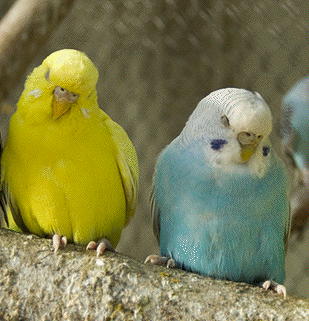
- Le bâillement chez les perruches Melopsittacus undulatus
- S'il est clair que certains primates bâillent de façon "contagieuse", et peut-être certains chiens, ce comportement n'a jamais été rapporté, jusqu'à présent, chez d'autres animaux. Le journal Behavioural Processes publie une étude décrivant un bâillement social chez la perruche Melopsittacus undulatus. Cette publication est la première rapportant "cette contagion" en dehors des mammifères, mais aussi pour la première fois "une contagion" de l'étirement ou pandiculation, autre comportement stéréotypé qui peut jouer une rôle social pour certains animaux.
- Michael Miller, Andrew Gallup et al. de l'université de Binghamton ont dirigé cette étude observant bâillements et l'étirements d'un groupe de 20 oiseaux mâles et femelles vivant ensemble.
- Les résultats suggèrent que bâuillements et étirements semblent discrètement contagieux chez ces perruches vivant en semi-liberté. En dehors de leur fonctions propres, ces comportements pourrait permettre une coordination des états mentaux et moteurs au sein d'un collectif d'oiseaux sociaux, mais d'autres études seront nécessaires pour approfondir ces données et les certifier.
-
Sensitivity to apomorphine-induced yawning and hypothermia in rats eating standard or high-fat chow - Baladi MG, Thomas YM, France CP.
- Psychopharmacology (Berl).
- 2012
- Influence of body weight and type of chow on the sensitivity of rats to the behavioral effects of the direct-acting dopamine-receptor agonist quinpirole
- Baladi MG, Newman AH, France CP.
- Psychopharmacology (Berl)
- 2011; 217:573&endash;585
- Dopamine D3 receptors mediate the discriminative stimulus effects of quinpirole in free-feeding rats
- Baladi MG, Newman AH, France CP
- J Pharmacol Exp Ther.
- 2010;332(1):308-315
- Eating high fat chow increases the sensitivity of rats to quinpirole-induced discriminative stimulus effects and yawning
- Baladi MG, France CP.
- Behav Pharmacol
- 2010;21(7):615&endash;620
- Apomorphine induced yawning in the rat:
- influence of fasting and time of day
- Naselo A, Tieppo C, Felicio L
- Physiology & Behavior
- 1995;57(5):967-971
-
Apomorphine induced yawning - Feeding conditions modify sensitivity to indirect and direct acting dopamine receptor agonists as well as the development of sensitization to these drugs.
- This study examined whether feeding condition affects acute sensitivity to apomorphine-induced yawning or changes in sensitivity that occur over repeated drug administration. Quinpirole-induced yawning was also evaluated to see whether sensitization to apomorphine confers cross-sensitization to quinpirole.
- Eating high-fat chow or restricting access to food alters sensitivity to direct acting dopamine receptor agonists (apomorphine, quinpirole), although the relative contribution of drug history and dietary conditions to sensitivity changes appears to vary among agonists.
- Yawning induced by DA receptor agonists yields an inverted U-shaped dose-response curve, and it is thought that the ascending limb of this curve (induction of yawning) is mediated by actions at D3 receptors and the descending limb (inhibition of yawning) is mediated by actions at D2 receptors .
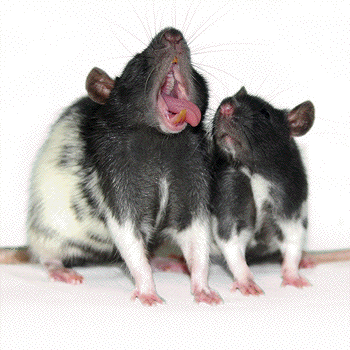
- Les
bâillements induits par l'apomporphine
Les conditions d'alimentation modifient la sensibilité des récepteurs à la dopamine aux agonistes directs et indirects. Cette étude porte sur les bâillements induits par une injection unique ou des injections répétées d'apomorphine (reflet de l'activité dopaminergique) en variant les modalités d'alimentation. Manger des graisses ou au contraire le jeûne modifient la sensibilté des récepteurs aux agonistes dopaminergiques (apomporphine, quinpirole) mais de façon variable suivant le type d'agoniste.
- La fréquence des bâillements induits par les agonistes dopaminergiques décrit une courbe en U inversé, dose dépendante. Il est considéré que le bras ascendant de la courbe (induction de bâillements) est le témoin de l'activité des récepteurs D3 et que l'autre bras (inhibtion des bâillements) est médié par les récepteurs D2.
-
Mandibular dislocation from yawning during induction of anesthesia - Unnikrishnan KP, Sinha PK, Rao S
- Can J Anaesth.
- 2006;53(11):1164-5.
- Clinical assessment of propofol-induced yawning with heart rate variability: a pilot study
- Tsou CH, Kao T, Fan KT, Wang JH, Luk HN, Koenig HM.
- J Clin Anesth. 2008;20(1):25-29
- Dislocation of the temporomandibular joint due to forceful yawning during induction with propofol
- Avidan AJ
- Clin Anesth
- 2002;14:159
- Hazard of yawning
- Tesfaye Y, Lal S
- Canadian Med Assoc J
- 1990;142(1):15
- Hazard of yawning
- Tesfaye Y, Lal S
- Canadian Med Assoc J
- 1991;145(12):1560
- Le bâillement thèse de stomatologie MC Forté Bordeaux, 1982
- A survey of temporomandibular joint dislocation: aetiology, demographics, risk factors and management in 96 Nigerian cases
- Ugboko VI et al.
- Int J Oral Maxillofac Surg
- 2005;34:499-502
-
Dislocation of temperomandibular joint when yawning occurs during the IV induction of general anesthesia - Yawning during iv anesthetic induction is an occasional clinical occurrence without known untoward effects. During iv induction, the typical sequence of clinical endpoints consists of loss of response to verbal command, followed by loss of eyelash reflex, occasional yawning, then apnea. The authors experienced an unusual complication of yawning in a patient during anesthetic induction.
- A 31 year old man with a recent history of head injury secondary to a motor vehicle accident was referred to hospital. In the neuroradiology suite standard monitoring was applied and the anesthesia circuit was connected to the tracheostomy tube with the patient spontaneously breathing. General anesthesia was induced with fentanyl 2 pg.kg iv and propofol 2 mg-kg iv.
- Physicians could not elicit standard clinical endpoints such as loss of response to verbal command and eyelash reflex, although the patient was observed to yawn during induction. Pancuronium 8 mg iv was administered, and anesthesia was maintained with 50% N in 02 and 1% isoflurane while the patient's lungs were mechanically ventilated. Surprisingly, the patient's mouth remained in a locked open position, and several attempts to close his mouth passively were unsuccessful.....

- Luxation de la mâchoire lors d'un bâillement pendant une induction aneshésique
- Le bâillement durant l'induction anesthésique est un évènement occasionnel sans inconvénient connu. De façon typique, se succèdent une perte de la réponse vocale à la commande, puis disparition du réflexe cornéen, suivie de bâillements occasionnels puis enfin une apnée. Les auteurs ont constaté une complication inhabituelle à ce bâillement de l'anesthésie.
- Un homme de 31 ans, récente victime d'un traumatisme crânien accidentel est conduit à l'hôpital. En service de neuroradiologie interventionnelle, une anesthésie est pratiquée alors que le patient ventile spontanément par une trachéotomie, induction faite avec fentanyl et propofol. Les médecins ne pouvaient pas user des critères habituels de contrôle mais visualisèrent des bâillements. Le patient fut curarisé et ventilé mécaniquement. C'est alors qu'ils constatèrent avec surprise que la bouche de la victime restait bloquée ouverte, avec impossibilité de la fermer de façon passive.....
-
Hemodynamic and metabolic effects of hemorrhage in man, with particular reference to the splanchnic circulation - Price HL, Deutsch S, Marshall BE, Stephen GW, Behar MG, Neufeld GR.
- Circ Res.
- 1966;18(5):469-74.
-
Yawning as a symptom of hemorrhagic shock - Eleven normal subjects were studied before and after removal of 15 to 20% of their blood volume within 35 minutes.This amount of blood loss did not produce conspicuous effects upon any of the usually measured circulatory or metabolic parameters. Yawning was the must frequent behavior triggered.
- The results suggest that the splanchnic circulation functions as an important blood reservoir in man, that it can be preferentially depleted of blood by a mechanism which does not automatically increase vascular resistance, and that the ability of the subjects to tolerate blood loss was attributable in large part to this response.
- Nearly all theories of the mechanisms involved in hemorrhagic shock depend upon observations made in anesthetized, infra-human species. Since anesthetics can modify circulatory responses and since species differences undoubtedly exist, it was elected to perform the present study in conscious human volunteers. The results differ in certain important respects from those previously observed or predicted during hemorrhage, and consequently they suggest the need for a more precise definition of what is meant by the term hemorrhagic shock.
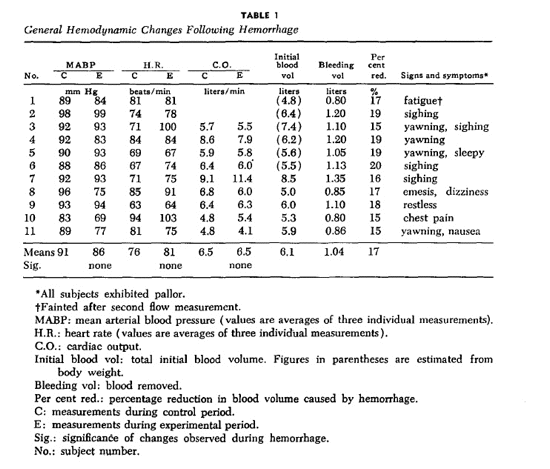
- Bâiller, un des symptômes du choc hémorragique
- Onze sujets normaux ont été explorés avant et après soustraction de 15 à 20% de leur volume sanguin en 35 mn. Cette quantité de sang ne produit pas d'effet évident sur aucun des paramètres usuels circulatoires ou métaboliques. Les bâillements ont été le signe clinique le plus fréquemment observé durant cette épreuve.
- Les résultats suggèrent que la fonction circulatoire splanchnique a un rôle important de type réservoir chez l'homme. Sa mise en oeuvre n'accompagne pas systématiquement une vasoconstriction et la tolérance éprouvée par les sujets est en grand partie liée à la mobilisation des réserves sanguines splanchniques.
- Pratiquement toutes les théories des mécanismes impliqués lors du choc hémorragique sont basées sur des observations de primates non humains sous anesthésie générale. Sachant que les agents anesthésiques peuvent modifier les réponses circulatoires d'une part et qu'il peut exister des différences entre les espèces, cette expérience a été menée chez des volontaires humains éveillés. Les résultats diffèrent des données recueillies antérieurement et, par conséquent, ils suggèrent de repréciser les définitions de ce qui s'appele un choc hémorragique.
-
Yawny - de Zhe
- Addictive Yawn Starter
- de Robert Soliday
-
Yawning ... for your iPhone or iPad 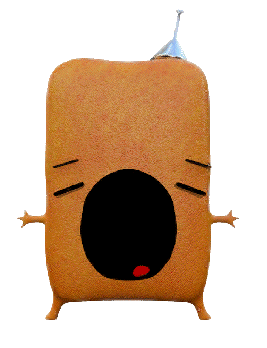
-
Yawn on Sunday - For media tycoon Rupert Murdoch, the Feb. 26 launch of the Sun on Sunday must have brought a degree of relief. On one level it fills the gap created by the closure of the disgraced News of the World. As he expressed rather excitedly on Twitter late last night, "Reports early, but new Sun edition sold 3m" &emdash; far more than the 2 million he had hoped for.
- On another level &emdash; and one far more important for a company some now associate with sleaze and alleged criminality &emdash; it serves as a handy p.r. talisman in News International's efforts to restore its credibility. The paper played it safe and critics yawned. "The Sun on Sunday was the Sun but not the Sun as we know it," Guardian media commentator Roy Greenslade wrote.
- Bâillement du dimanche
- Lancée par Rupert Murdoch en personne le 26 février 2012, l'édition dominicale du tabloïd britannique Sun on Sunday oscille entre niaiseriea et bons sentiments.
- Tiédasse, limite rasoir, le Sun on Sunday, lancé en fanfare par Rupert Murdoch, n'a pas franchement emballé les foules. Au point que Denis MacShane, député travailliste et ancien ministre des Affaires Européennes, a suggéré sur Twitter un titre plus approprié : le Yawn on Sunday («bâillement du dimanche»). Pas de scandales juteux, d'homme politique ou de footballeur pris dans un lit inédit, pas d'histoires d'argent détourné, de tricheries invraisemblables, pas de sang, rien des habituelles nouvelles de caniveau...
-
You Ask, We Nurture (YAWN)
-
New parents keep YAWNing - You Ask, We Nurture (YAWN) is an in-home volunteer scheme that uses gentle techniques to support and nurture families with sleepless babies. Jeanette Crawford is the co-founder of You Ask, We Nurture (YAWN), who provide a service to help out tired carers. Participants in the YAWN program will have a volunteer come into the family home and look after the child while the mother or father has a sleep or tends to other duties.
-
A case of Charcotian grande hystérie: Observation by Julien Offray de La Mettrie in 1738 - Walusinski O.
- European Neurology
- 2012;87(2):98-106
-
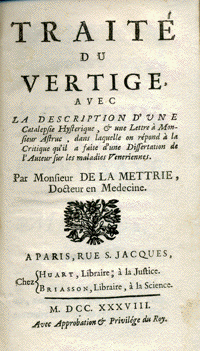
-
A Case of Charcotian grande hystérie: Observation by Julien Offray de La Mettrie in 1738 - Julien Offray de La Mettrie (1709-1751) is a French philosopher who owes his fame to his materialist ideas. He was also a provocative atheist who used his scathing pen to defend the first concept of a theory of mind. We offer here one of his little-known works, reporting on a case of grande hystérie, as Jean-Martin Charcot (1825-1893) and his student Paul Richer (1849-1933) would describe the condition 150 years later. After discussing how La Mettrie interpreted this observation, we will compare it to interpretations developed during the 19th century, in particular by the La Salpêtrière school.

- Une grande attaque d'hystérie de Charcot observée par Julien Offray de La Mettrie en 1738
- Julien Offray de la Mettrie (1709-1751) est resté célèbre comme philosophe matérialiste français. Provocateur athée, il usa de sa plume acérée pour défendre la première conception d'une théorie de l'esprit. Nous proposons ici un de ses écrits méconnu, rapportant une grande attaque d'hystérie comme Jean-Martin Charcot (1825-1893) et son élèvre Paul Richer (1849-1933) la décriront 150 ans plus tard. Nous discuterons alors de l'interprétation qu'il en donna et la comparerons à celles développées tout au long du XIX° siècle, notamment par l'école de La Salpêtrière.
-
Autres documents mis en ligne ce mois-ci :
- Juvenile First Rib Fracture Caused by Morning Stretching. Lee SJ et al
- Dopamine D3 receptors mediate the discriminative stimulus effects of quinpirole in free-feeding rats. Baladi MG et al.
- Moëbius' syndrome and yawning
- Darumas Dolls
- Dopaminergic D2-like agonists produce yawning in the myelin mutant taiep and Sprague-Dawley rats. Eguibar JR, et al.
- Auditory contagious yawning in domestic dogs (Canis familiaris): first evidence for social modulation. Silva K, et al.
Résultats du sondageau 30 avril 2012 Recherche par mot du site
-
Nombre de questionnaires remplis : 6005 - Combien de fois bâillez-vous par jour ? <5 = 23,3%.. 5-10 = 23%.. 10-15 = 15,2%.. 15-20 = 10,5%.. >20 = 28%
- Ressentez-vous des baillements excessifs ?
- 53,4% = non, tant mieux
- 36,2% = oui et je ne sais pas pouquoi
- 8,9% = oui et je prends des antidépresseurs
- 1,0% = oui et je prends des anti-épileptiques
- 6,2% = oui et je prends d'autres médicaments
- 2,3% = oui et j 'ai des troubles neurologiques
- 2,3% = oui et j 'ai des troubles hormonaux
- 1,5% = oui et j 'ai des tics moteurs
- 1,6% = oui et j 'ai des tocs
- déclenchez-vous facilement le bâillement d'autrui ? 74,6%
- êtes-vous sensible au bâillement d'autrui ? 68,8%
- J. Curnow
- The tendancy to appear exact by disregarding the complexity of the factors is the old failing in our medical history
- Une erreur, bien ancienne, rencontrée dans l'histoire de la médecine est de ne pas tenir compte de la complexité des facteurs pour paraître exacte.
baillement.com baillement.info yawning.info écrits et réalisés par le Dr Walusinski
lire les lettres précédentes d'information du site tapez votre email - give your email pour ne plus recevoir cette lettre - to unsubscribe to the website's letter:

